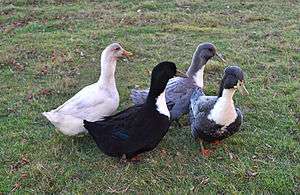Swedish Blue
 Swedish Blue ducks, with two blue birds on the right and splash and black forms to the left | |
| Conservation status | FAO (2007): critical[1] |
|---|---|
| Other names | |
| Country of origin | Sweden |
| Traits | |
| Weight |
|
| Classification | |
| APA | medium duck[2] |
| EE | yes[3] |
| PCGB | heavy[4] |
| |
The Swedish Blue (Swedish: Svensk blå anka)[5] or Blue Swedish is a Swedish breed of domestic duck. It emerged during the nineteenth century in what was then Swedish Pomerania, now divided between north-west Poland and north-east Germany.[6][7]
History
The Swedish Blue emerged during the nineteenth century in what was then Swedish Pomerania, now divided between north-west Poland and north-east Germany; the first documented mention is from 1835.[6][7] Some birds were exported to the United States in 1884, and it was added to the Standard of Perfection of the American Poultry Association in 1904 as the "Swedish", with the single color variety "blue".[2][7]
The population of the Swedish Blue in Sweden consists of only 148 breeding birds; its conservation status world-wide was listed as "critical" by the Food and Agriculture Organization of the United Nations in 2007[1] and in 2014 was listed as "endangered-maintained" in Sweden.[8] No data is reported from Ireland, the only other country reporting the breed.[9] It is listed as "watch" by the American Livestock Breeds Conservancy.[7] The Blue Swedish is not a popular exhibition breed either; specifics on wing color make the breed challenging to perfect and often discourage breeders and hobbyists from owning the breed.[10]
Characteristics
The Swedish Blue is a medium-sized bird: the male weighs between 3–4 kg and the female usually weighs 2.5–3.5 kg. Swedish ducks are regularly compared to the body type of Cayugas and Orpingtons, however Swedish should have shorter bodies with more width compared to what is seen in those two breeds.[10] Blue Swedish have medium, oval-shaped heads.[11] Color should be a consistent blue-slate with darker lacing around the border of each feather. Drakes are generally darker than ducks.[11] The only part of the birds that is not some variety of blue is the white, heart-shaped bib found on the breast, extending up the front of the neck terminating towards the mandible of the bird.[11] It is distinguished from the Pomeranian Duck by its white primaries.[6]
The blue color is due to heterozygosity in a dilution gene. As in other blue poultry such as the Blue Andalusian breed of chicken, if a two blue birds are bred, the young are, in the usual Mendelian proportion:
- 25%: a homozygous form, black where the blue should be
- 50%: heterozygous, the typical blue
- 25%: the other homozygous form, splashed or silver with combinations of blue and black and white.
Thus only 50% of the offspring of a blue-blue mating are blue. If the black and splash homozygous forms are bred together, the offspring are all heterozygous and thus the desired blue color.[12]:36, 352
Use
Ducks lay some 100–150 white or tinted eggs per year of 80–90 g weight.[7]
References
- 1 2 Barbara Rischkowsky, D. Pilling (eds.) (2007). List of breeds documented in the Global Databank for Animal Genetic Resources, annex to The State of the World's Animal Genetic Resources for Food and Agriculture. Rome: Food and Agriculture Organization of the United Nations. ISBN 9789251057629. Accessed August 2014.
- 1 2 3 APA Recognized Breeds and Varieties: As of January 1, 2012. American Poultry Association. Archived 4 November 2017.
- ↑ Liste des races et variétés homologuée dans les pays EE (28.04.2013). Entente Européenne d’Aviculture et de Cuniculture. Archived 16 June 2013.
- ↑ Breed Classification. Poultry Club of Great Britain. Archived 30 June 2017.
- ↑ Breed data sheet: Svensk Blå Anka/Sweden. Domestic Animal Diversity Information System of the Food and Agriculture Organization of the United Nations. Accessed August 2014.
- 1 2 3 Ducks. Poultry Club of Great Britain. Accessed June 2018.
- 1 2 3 4 5 Swedish Duck. Pittsboro, North Carolina: The Livestock Conservancy. Accessed June 2018.
- ↑ Transboundary breed: Swedish Blue. Domestic Animal Diversity Information System of the Food and Agriculture Organization of the United Nations. Accessed August 2014.
- ↑ Breed data sheet: Swedish Blue/Ireland. Domestic Animal Diversity Information System of the Food and Agriculture Organization of the United Nations. Accessed August 2014.
- 1 2 Holderread, Dave (2001). Storey's Guide to Raising Ducks. North Adams, MA, USA: Storey Publishing. pp. 64, 65.
- 1 2 3 Standard Revision Committee; Malone, Pat; Donnelly, Gerald; Leonard, Walt (2001). American Standard of Perfection 2001. USA: American Poultry Association. pp. 312, 313.
- ↑ Victoria Roberts (2008). British poultry standards: complete specifications and judging points of all standardized breeds and varieties of poultry as compiled by the specialist breed clubs and recognised by the Poultry Club of Great Britain. Oxford: Blackwell. ISBN 9781405156424.